
The Fall
Stories are inevitably a reflection of their creators, of humanity. Humanity is never roundly good nor bad. Most humans are a mixture of various characteristics and there is often a traceable line of logic (though often only logical to the subject) from their experiences and beliefs to their actions. Thus, we see very early in the history of storytelling antagonists who are not plain evil. Many early cultures had characters who have hard personality types or flaws that drive them towards antagonistic and/or violent actions based on their situation, rather than those characters just being ‘bad.’
Soon enough, storytellers and audiences became enamored with the process by which someone ‘good’ becomes ‘bad,’ a process which in this article we’ll call The Fall. Many stories over the centuries have used versions of the fall but it is particularly popular in recent speculative fiction.
What is the Fall?
In so many words, the fall is when:
A character trait, motivation or belief comes in conflict with the character’s situation or environment, leading them to an extreme change in goals or behavior. These changes leads the character to act as an antagonist.
A fairly well-known example is Anakin Skywalker / Darth Vader[1]. Skywalker’s goals of developing his powers and pursuing his relationship with Padme not only conflict with the environment but also each other. The conflict leads him to switch alliances while ultimately believing himself to be in the right all along.
The fall comes in several flavors.
Flaw-based
Here a character flaw, along the lines of the Greek tragic flaw, leads the character to pursue activities they know to be morally wrong, often due to a great temptation or misunderstanding of their own situation. In the Lord of the Rings[2], Saruman’s pride and desire for power lead him into aiding his enemy Sauron.
Belief-based:
In this form, a character’s deeply held belief leads them astray. The Autopilot in Wall-e[3] believes that humanity will be safe in space. He believes human life is about safety and comfort, blinding him to the value in taking humanity back to a dangerous Earth.
In Avatar: The Last Airbender[4], Zuko believes his father’s approval is the same as honor and happiness causing him to act as the series’s main antagonist until he is able to change this belief and becomes an instrumental protagonist. This switch is one of the brilliant aspects of Avatar and highlights the mixture of good and evil inherent in the characters, either side of which is exposed by the interaction of their beliefs with the situation.
The belief-based fall is very common in any narrative about religious or political extremism, for example on such subjects as the Spanish Inquisition.
Trauma/Hardship-based
Often a traumatic experience is the basis for an antagonist’s behavior. In the space-western Trigun, Knives is traumatized by abuse and by seeing another of his species dead from repeated vivisection and experimentation by humans. He spends the rest of his life hating humans, believing them incapable of self-control or compassion. Despite his beliefs about humans, this fall is not belief-based. His actions are constant, visceral reactions to the trauma and his beliefs are formed to rationalize his reactions and emotions.
Generational
One last common type of fall is not defined by how the fall actually happens. Generational fall occurs where we see generations or hierarchies of antagonists formed in a cascading fashion. Looking at Tolkien again, Morgoth falls due to hubris. Sauron falls and becomes Morgoth’s lieutenant. The leaders of men become the Nazgûl in the service of Sauron.
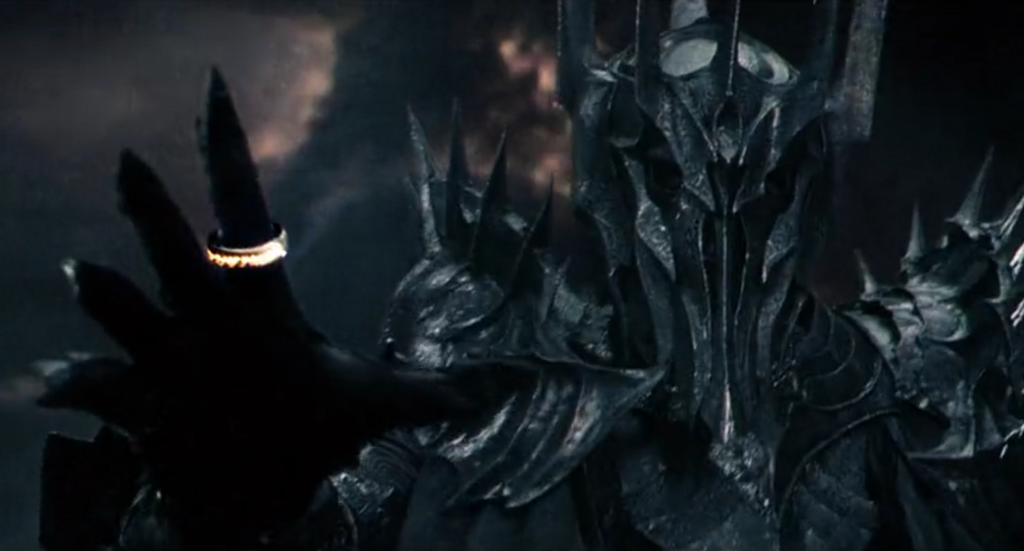
In Warcraft, Sargeras falls due to his hatred of the Void. The Eredar fall to serve Sargeras, the Orcs fall to serve the Eredar; it’s corruption all the way down[5].
Each generation falls for different reasons and have different motivations and goals. But one commonality to depictions of generational fall is that evil begets evil generally because one antagonist can sense and prey on a character’s weak spots (beliefs, flaws or experiences) to guide them into certain behaviors. These behaviors often lock the character into the antagonist side because they feel they cannot be redeemed or are afraid of their parent antagonist’s revenge.
Another common theme is the hypocrisy of power. In almost all cases, each generation is attracted to their parent generation’s power. These antagonists wish to have enough power that they can be truly independent, without fear or needing to serve others. But ultimately, they need to serve a more powerful antagonist, often while being in constant fear, in order to gain more power. Thus, generational falls are a powerful tool for storytellers looking to examine themes of power.
A Turning Point
The actual events leading to the fall can vary widely and are not dependent on the type of fall. A temptation too strong can lead to both belief-based or flaw-based fall. Difficult moral decisions can cause trauma or prey on one’s beliefs. Any of these falls can be slow or fast. Thus, the story that one wants to tell is not limited by the type of fall one uses or the themes that fall relates.
That said…
The fall is an interesting story element because it does try to accept the complexity of humans. That said, like any mechanic, it can be overused and poorly used. Thus the antagonist who was once on the side of good can feel a bit clichéd if not done with nuance and care. The fall tends to come out badly if it is:
Unimportant
The fall is just a random detail thrown in there as a hand-wavy explanation for the antagonists motivations or backstory. There’s no point to having the fall if the storytelling isn’t going to commit. The story would be just as good by skipping over the backstory or using a simpler explanation/history. If the storyteller doesn't show that they care about the fall, why should the audience.
Shallow
Often, storytellers use the fall as almost a throw away line saying ‘power is bad.’ The character’s fall due to lust for power is presented shallowly and unbelievably. Audiences have heard about the corrupting force of power for millennia. If you’re going to comment now, your message better have depth or something new to say.
Set Dressing
As a cliché and a long-standing genre standby, many fantasy and science fiction storytellers just throw a hodge-podge of genre elements into their plot without putting much thought to making them natural, meaningful elements of the story.
Some beginning storytellers take elements of stories they’ve loved without fully understanding why those elements made the story exciting. There’s nothing wrong with this method; it fact, it’s a great way to start exploring the art of storytelling. But as one progresses, each brick needs to be laid with care and meaning.
A Convenient Explanation
Often the fall represents a descent into the irrational. When a storyteller has an otherwise very rational character but needs to justify some very irrational antagonistic actions, they throw in the fall as a quick fix.
The conflicts and changes inherent in the fall need to make sense with the character and their journey. Time needs to be taken to show why this character becomes irrational at this point.
Justification
The tragic backstory has become a staple of storytelling in the last 20 years. The antagonist who commits terrible atrocities (or is just a real jerk) was abused as a child or lost someone important to them. Of course it is not uncommon in real life for those who abuse to have been abused themselves and almost everyone who does terrible things has their own pains they’ve lived through.
The problem arises when this depiction comes off as 1) a justification for their behavior and/or 2) an attractive point about the antagonist. We are each responsible for our actions and while a tortured past may explain destructive behavior, it never justifies it. And it is a terrible precedent to set when we fetishize someone’s abuse, when we say that the awful things they’ve been through are an attractive quality rather than a tragedy or that the resulting abusive behavior itself is attractive rather than unacceptable.
The Perpetual Story Machine
Generational falls are often used as an explanation for never-ending, cyclical stories. There’s always another boss, another antagonist waiting around the bend that justifies the creation of another book, film or game in a franchise. If planned out very carefully and with restraint, generational falls can create a beautiful story arc. But 90% of the time, the stories feel repetitive and phoned in. Avoid this.
These stories usually work from the bottom up through the hierarchy of antagonists. There is an original, well designed plot where the protagonist overcomes the antagonist. But pressure to sell a sequel causes the storyteller to decide, no, that wasn’t the real antagonist, just a lackey for an even worse antagonist, etc.
One of the only examples of this technique working is Sailor Moon[6] which was so brazen and transparent about the cycle of antagonists that we could safely ignore it as kitschy.
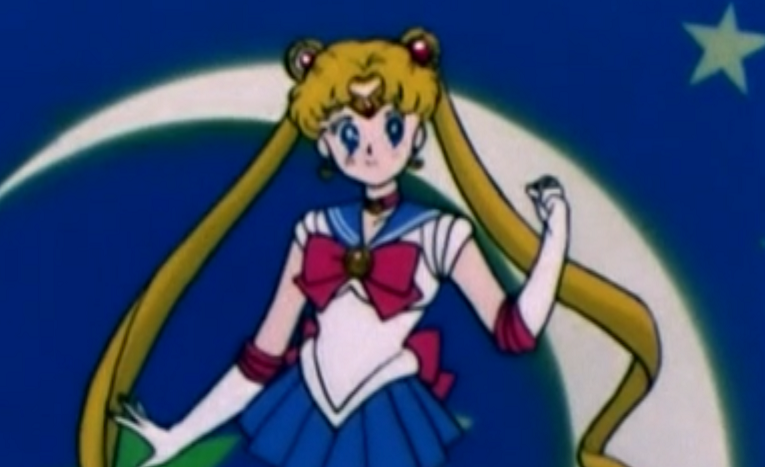
Let’s Do Better
That is not to say one should avoid the fall completely. As with any tool, it can work wonders when handled with care. The fall is a beautiful story mechanic when it is:
Symbolism
When the character and their fall represents a real social transition, their journey resonates deeply with any audience familiar with that change. The character’s transformation is a great tool to describe the greater society.
In Princess Mononoke, Nago the boar god represents mythologized nature, beyond human comprehension and control. The bullet which corrupts him into a demon represents the clash of mythologized nature and modern society, driven by science and the belief that nature can be understood and controlled. Thus his personal fall mirrors a grand societal change that resonates with any viewer familiar with the last two centuries of human history.
A Reveal of the Inner Reality
The fall by its nature demands that the antagonist was at one time not an antagonist. They were good before they went bad. The fall represents this change particularly well when the conflict driving the fall is between the character’s outer presentation and their inner reality.
Arthas from Warcraft starts life, to outward seeming, as a capable boy who embodies the values of his kingdom. But inwardly, he harbors a deep seated selfishness and lust for power. Thus, his fall illustrates a natural and compelling conflict between these two aspects of himself and the eventual victory of his inner reality over the outer facade.
Complex
The fall is a process, a journey. It is not flipping a switch on someone’s personality or behavior. There will almost always be a struggle as the character changes their goals, a resistance within them to that change.
Additionally, if the storyteller takes the time to include the fall into their plot, the audience will inevitably ask “why?” The storyteller should know what the purpose of the fall is in the story. Does it say something about society? Is the audience supposed to sympathize with the antagonist? Is it an important part of the relationship between the antagonist and another character? The fall, as with all story mechanics, should be used purposefully. Otherwise, perhaps it’s better to use a different justification/motivation for the antagonist’s actions.
Thus, the storyteller should take their time with the fall. It should be shown in at least enough detail to carry out its purpose and to have an impact. The fall cannot be an on/off switch on character behavior but is, by definition, a means to seeing complexity in the character and thus must be complex itself.
Prime Examples:
Some of these I’ve touched on earlier but I’ll go a bit more in depth to show how effective the fall can be as a communication and engagement device.
Princess Mononoke[7]
As stated above, Nago, the other animal gods and the Great Forest Spirit all represent the mythologized nature which humans cannot control. Lady Eboshi represents scientific progress which can rival and control nature. Irontown is thus the implementation of that progress. Nago’s corruption from a bullet wound represents the clash between the old and new views of nature and its outcome. Nago become destructive (as a toxic water table might) and eventually dies.

The movie resolves when the Great Forest Spirit dies, causing Lady Eboshi and the denizens of Irontown to rethink their relationship with nature. San also rethinks nature’s relationship with humans as potentially not confrontational and survives as the wild power of nature that cannot be completely controlled.
Thus the fall encapsulates and communicates a Hegelian dialectic of (thesis) nature is more powerful than humans, (antithesis) humans are more powerful than nature and (possibility of synthesis) nature and humanity negotiate a relationship as equals.
Nago’s fall represents a philosophical struggle that is still very salient today. Part of why Princess Mononoke is so engaging because the fall connects high-level social discussions to character interactions which engages the audiences social reality in concert with their understanding of personal interactions.
Arthas (Warcraft)
Arthas’s[8] fall is more of a character study than a social message. He grows up surrounded by role models who embody a sense of wisdom and duty. Yet he is filled with pride, lacking self worth, terrified of being controlled and constantly in need of more power. Yet, his view of himself is based on his childhood role models and he continually tries to understand himself from the perspective of their virtues.
The combination of the flaws with this self-view creates someone who cannot admit any his flaws of this to himself without his self image crumbling. When he is criticized or rejected, he cannot admit that he might be wrong or that he might be feel so weak that he would react with anger. Thus he rationalizes his anger as righteous anger and re-explains the world through that lense. When he fails, he must blame others. He is both unable to admit his faults or his fear of those faults.
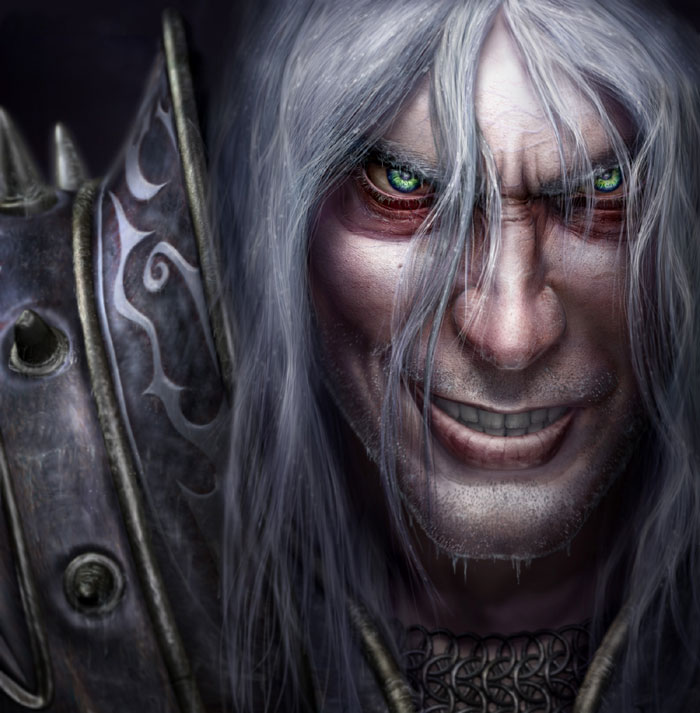
The first half of Arthas’s fall coincides with the advent of his adulthood, the increase of responsibilities and the decrease of oversight. His latent, inner self is allowed to drive his actions while he can still maintain some outward veneer of noble pretense. Once he has thoroughly convinced himself that all his old role models have forsaken their values and that he is the exponent of those same values, he continues on the fall with his self image still intact.
Arthas is also one in a long line of falls in the Warcraft universe. His fall is facilitated Emperor Palpatine style by Ner’zhul. Arthas is probably the most beloved villain in the Warcraft universe and it is because his character and his fall are complex and communicate a meaningful conception of the struggle between right and wrong in the franchise.
Knives (Trigun)
In the anime Trigun[9], Vash and Knives are two brothers who are Plants, a sentient species discovered/created by humans. The audience begins the narrative in the present day knowing that Knives is a villian and eventually goes back to his childhood through flashbacks to see his fall. Thus, the depiction of his fall serves to readjust audience expectations, adding more emotional depth by providing a clash between the expected and the actual.
Vash and Knives are discovered and raised on a human ship. While boys, they find the body of another Plant who was previously discovered on the ship. This plant died from vivisections and cruel experiments by the humans. This discovery causes both brothers to reexamine their sense of right and wrong and their relationship with humans.
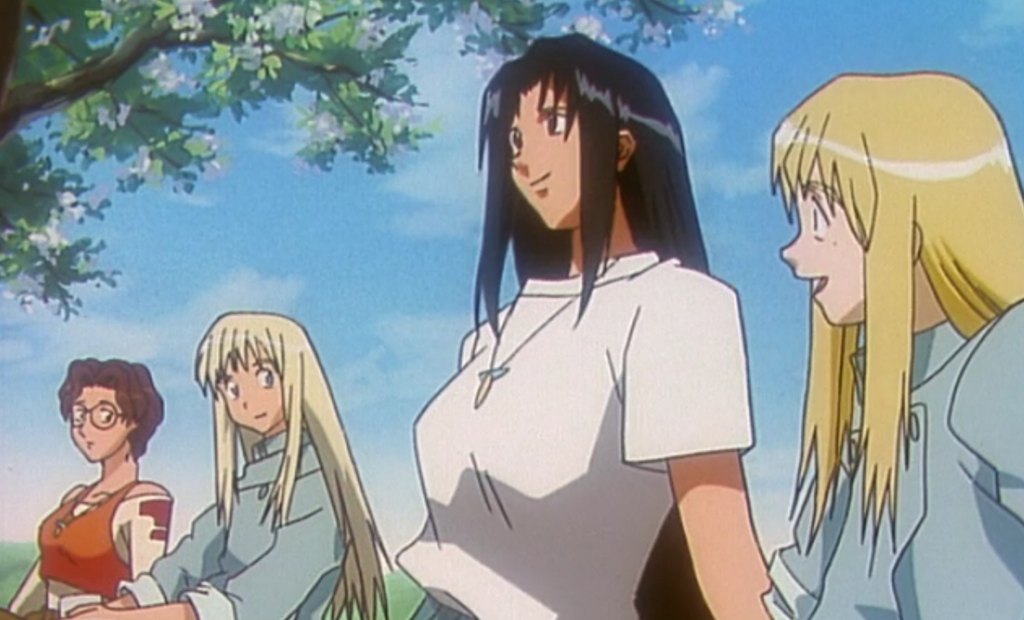
Knives decides to destroy humans to create a world where he and Vash can be safe. Vash initially contemplates suicide but ends up deciding to protect humans, valuing their potential goodness despite their potential destructiveness.
Knives’s fall occurs not only as a break with audience expectations but also as an obvious foil to Vash’s path in life. The inciting incident of his fall, the discovery of the vivisected Plant, is so visceral and cruel that his actions in the present day are more understandable and meaningful that the initially goofy tone of the story lets on. Again, the complexity of the moral questions Vash and Knives are confronted with at a young age contributes directly to the emotional depth of the story.
Additionally, the severity of that inciting incident and the very real danger humans pose to the Plants gives the audience the sense that Knives is capable of doing anything at any moment, providing a believable sense of tension throughout the series.
Tetsuo (Akira)
Tetsuo is not exactly the antagonist of the wonderful 1988 anime film Akira[10]. One of the great parts of the film is that no particular character or group could be called a true antagonist. But he often acting in opposition to the protagonists, Kaneda and Kei. Tetsuo begins developing psychic powers, eventually posing a danger to the entire city.
Tetsuo’s transformation is one of the most believable mainly because he is a child. He and Kaneda have a little brother / big brother dynamic that Tetsuo begins to chafe under as he becomes a teenager. This sense of not needing help and not wanting to be told what to do is his ultimate driving force. Piece by piece he destroys everything he has cared about in his life, his home and hangout, his friends, his girlfriend and eventually the city.
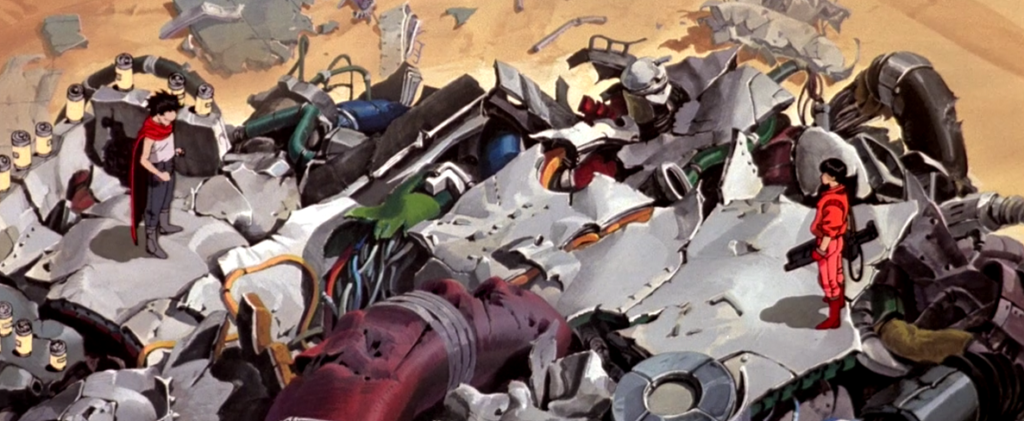
In many stories that use the fall mechanic, the characters often feel like children in adult bodies because their actions leading to the fall are immature, based on imbalance priorities or are just emotional outbursts with no clear motivation. This phenomenon is more often a lack of attention or finesse on the part of the storyteller rather than intentional depictions.
But Tetsuo’s actions are intentional depictions of a teenager struggling with a quasi coming-of-age moment and they are well-motivated. The fall in Akira is a wonderful example of the mechanic because it both clearly fits with the character’s motivations and personality while being a natural and seamless fit with the plot mechanics. Pulling the fall off this well takes a lot of thought and work but the results are worth it.
The Illusive Man (Mass Effect[11])
In Mass Effect 2, the Illusive Man does not present himself as someone who is ‘good’ according to the standards of larger society. He is an open extremist but still a certain kind of idealist. He believes his actions, usually destructive to galactic peace, are positive for humanity. But his wealth and resources remove any kind of boundaries on his behavior and disconnect him from the consequences of his actions as much as his ideology does. The alien technology he takes control of at the end of the game takes this freedom even further.
The stakes rise in Mass Effect 3 as the Reapers begin their mass extinction of the galaxy’s sentient life. The potential technological opportunities the Illusive Man possesses combined with the present danger are the factors that force the Illusive Man to the precipice of his fall. He embraces the potentials of Reaper technology thinking he can use them to control the Reapers. The end result is the Reapers gaining control over him.
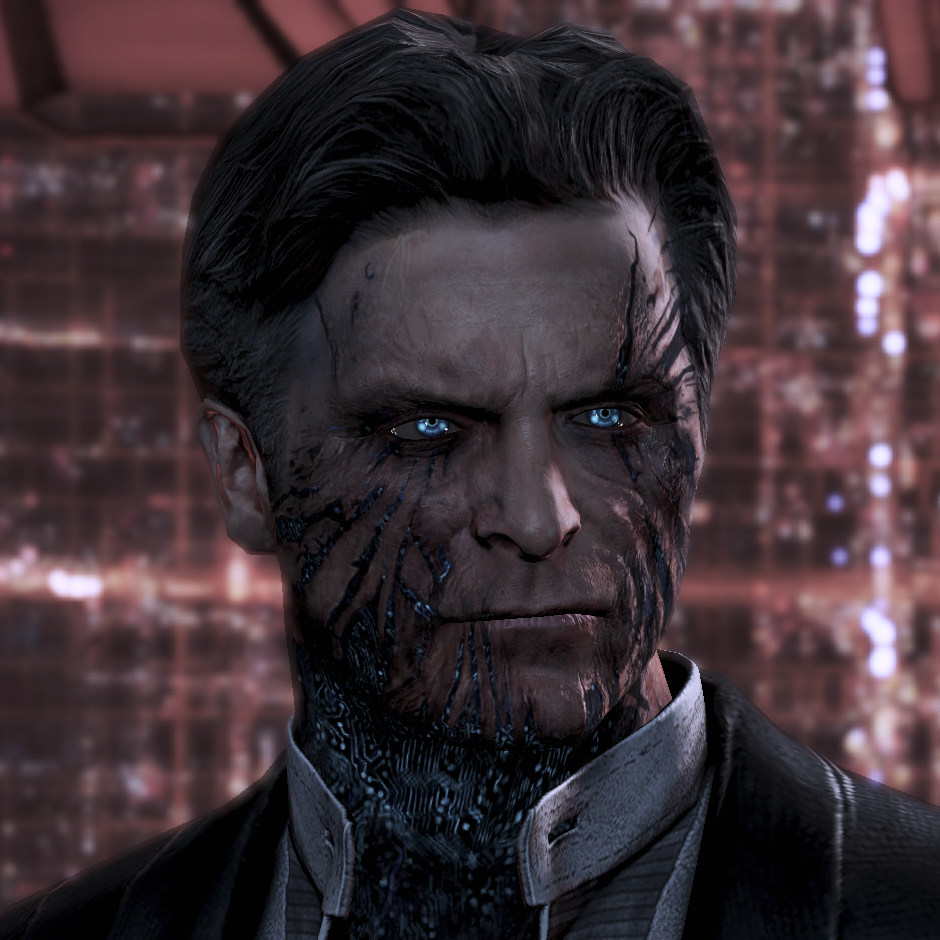
The Illusive Man’s fall is multifaceted. It is primarily built upon his xenophobic ideology of human supremacy and his hubris at believing he can save humanity single-handedly. These elements are mirrored by his genuine desire to help the galaxy and prevent humanity’s extinction. As stated above, the push point comes when he has the temptations of power and a solution combined with an increasing threat.
There presentation of the fall in Mass Effect is interesting precisely because of the dichotomy in the Illusive Man’s motivations. Arthas’s fall from above was essentially pulling off of a mask of goodness to expose an existing evil beneath. His internal belief in his own righteousness is a means to keep himself psychologically afloat and not a reflection of his true motivations.
But the Illusive Man genuinely wants to do good even to the end. His character flaws blind him and corrupt how he goes about trying to do good. His drive to do good is not supported by truly altruistic beliefs so he is not an immediately pitiable character nor does his fall feel like an arbitrary corruption mechanic for ‘story reasons.’ His beliefs are flawed, hopeful and hateful, and so he represents real inner conflicts society has in its view of itself.
His fall feels real because it follows his motivations and his motivations are conflicted. He is not a do-gooder who did bad. He is a real person who has done both good and bad but who ultimately destroys himself.
In the End
The fall is a particularly interesting mechanic because it directly engages the western view of good and evil and tries to create something more human, more empathetic. When used appropriately and with any level of serious thought, it tends to have a very positive impact on story quality. The fall is a prime example that when stories are more real and more human, they are undoubtedly better.
Footnotes:
- [1] From Star Wars
- [2] Plot Summary
- [3] 2008 animated film by Pixar
- [4] One of the best animated shows ever
- [5] Apologies for the overload of fantasy names
- [6] Originally a manga but most remembered as an anime from 1992
- [7] 1997 anime film directed by Hayao Miyazaki
- [8] Major villain in the multi-genre franchise. He is highlighted in Warcraft 3, Wrath of the Lich King expansion to World of Warcraft and the Christie Golden book, Rise of the Lich King
- [9] 1998 space-western anime based on a manga, we'll ignore the differences with the manga here
- [10] Plot, we'll ignore the differences with the manga for now.
- [11] Science fiction game series debuting in 2007